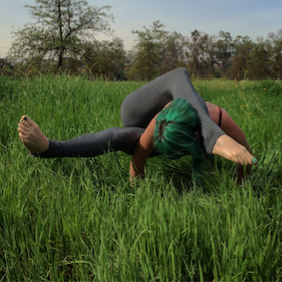At some point in our lives, we have seen someone with extreme flexibility and wondered how on earth their movements were possible.
Surely our own bodies would snap in half before bending into such unimaginable shapes. Maybe we feel like the walking tin man, forever in need of extra lubrication for our bodies to move. Maybe we aren’t quite that stiff, but we have some areas of our bodies that are exceptionally tight.
As a yoga instructor, I’ve quickly come to notice just how important stretching is, not just for me, but for everyone. The benefits of stretching first start in the body, where we are able to release stiffness, tension, discomfort and pain. We can literally heal our bodies through the mindfulness of our movements, stretching to create space. The benefits also help us have a more flexible mind. Any limiting thoughts we may have, open through stretch, to the vastness of possibility.
We all know that stretching provides these benefits, so why don’t we do it? A lot of the time we don’t stretch because we have no idea how. Stretching may feel painful. Or we don’t have the time. There are a million reasons we can come up with to avoid working on opening up our bodies, but there are ways to work around all of these things. I have spent years learning the following steps to help me grow both in my mental and physical flexibility. These steps have literally changed my life. I can only hope to serve others on their journeys by passing these along. Here are 11 ways to become more flexible.
One: Believe.
This step is huge. In order for us to start opening our bodies, we have to first believe that we can. This means releasing the “can’t” from our vocabulary, a word that gets thrown around way too often. It doesn’t matter where we start; injured, stiff, overweight, old or young. We have to see that, with time, we are all capable of reaching our goals. An open mind can help create an open body. The more we believe, the more we form our realities.
Two: Let go of judgement and comparison.
Judgement and comparison can put a damper on almost any new endeavor. If we are constantly comparing ourselves to others, while placing judgement on ourselves, we are being robbed of our own growth. Some of us have been practicing for years and some of us are brand new to this journey. Every single body is going to feel and be different. What we’ve experienced in our life, how we cared for our body, our structural build or even our thoughts. All of these things are factors in our overall flexibility. We have to let go of our judgments and comparisons in order to experience our own authentic process.
Three: Drop expectation.
Expectation can block our growth. We often go into new endeavors with the thought that change will happen overnight. If we can’t touch our toes by the end of the month, then it’s not happening fast enough. Whatever expectations we have for our bodies, we need to let them go. Every day we will feel different, so every day we will need to accommodate our bodies differently. We must accept that sometimes our bodies won’t do what we want them to or what we think they should. That’s okay.
Four: Align.
The importance of alignment can not be stressed enough. Throwing ourselves into random shapes without understanding how it’s benefiting or harming our bodies can be extremely dangerous. There are reasons behind stretches or why poses are done in certain ways and sequences, in order to engage or release specific areas and to avoid injuries. There are even subtle ways to fine tune, that we wouldn’t normally notice without instruction or a deep level of awareness. The best way to learn correctly and efficiently is to find a well-educated instructor to help. A good instructor will inform and educate on the specifics of stretching and opening the body in a safe and mindful way. Not every way will work for everyone. Modifications and alternate poses may differ from person to person. Find a class or private teacher to learn the necessities. This will allow for a safer, quicker and more efficient progression.
Five: Be aware.
Awareness is the perfect followup to alignment. The more we can learn how to move and open our bodies, the more aware of them we become. We know when our bodies feel more stiff or open. We can tell when they need to be stretched or rested. This is extremely important. Different areas throughout the body will also feel significantly different than others. Maybe we favor a side of our bodies, ignore certain areas because they feel tighter and glorify the areas that aren’t as difficult. Being aware of these tendencies allows us to find room to improve and grow. We also learn to find our personal edges. We know when we are not pushing ourselves enough or when we have reached our physical thresholds. We must find that sweet spot and respect that edge. It’s all about being kind to ourselves. Without awareness, we are mindlessly stretching rather than consciously opening.
Six: Find depth.
Oftentimes. when we think about stretching, we focus on our muscles. This is a great place to start, but as we begin to ease into the muscle tissue we can start to think deeper. What we tend to neglect are the connective tissues, the webbing that connects everything throughout the body. Without stretching these connective tissues, they tighten and harden causing us to feel more tension and resistance. The only way to tap into the connective tissue is by passive release; disengaging the muscles and relaxing into the space between the joints. This technique may not feel like much at first, but after a few minutes, the sensation will deepen. This also leads to a release of any emotions stored within the tissues of the body. The release of these tissues, deep below the surface, is the gateway to our flexibility.
Seven: Have patience.
In order for us to make a change, we have to embrace the time it will take to get there. Flexibility doesn’t come overnight. It may take months or years to open and release areas of our bodies. Not to be discouraged. This doesn’t mean we won’t experience progress. This point goes along with releasing expectations. What we think will take a week, may take six months or longer. We have to realize that it’s not about the destination but the journey itself. This is where we learn and grow the most. Patience also means taking time in a pose or stretch. Twenty seconds of reaching toward our toes or butterflying our legs won’t make noticeable change. We need to fully be with each pose and allow the body to open with time. Opening connective tissue requires three to five minutes minimum before the magic even starts to happen. Embrace the process of letting go and be with the discomfort.
Eight: Be consistent.
Taking the time to stretch here and there won’t get results. It takes commitment to the practice in order to see results. Making time in our schedule is a key component. If we want it enough, we will make the time. If we can designate at least 20 to 30 minutes to stretch, at least four times a week, we will start to notice big improvements. It’s really not that much time in the grand scheme of things, but it does create noticeable change in not only our bodies, but in our minds. After a while this will become easier to do. Our bodies soon begin to crave the space we’ve worked to create. Maybe we even work ourselves up to a daily practice.
Nine: Breathe.
This may sound like a no-brainer, but breath is often overlooked. Breathing is the language of the body. It teaches us so much about awareness and inner release. Sometimes our breath feels short, it speeds up, we hold it or it feels strained. This is our body speaking to us. Slow down…back out…ease in. We should always take full deep breaths that we can use to consciously guide us throughout the body as we are stretching. The more we can emphasize the breath, the more space we can create inside of the body. It will help us surrender more deeply by calming the mind and relaxing any physical tension.
Ten: Be still.
Stillness goes hand in hand with patience. As we give ourselves time to sit silently with our bodies, we can go inside ourselves to find the stillness that resides there. Stretching can feel extremely uncomfortable, especially when first starting out. That discomfort triggers the mind to start speaking to us. It tells us how much we dislike certain positions, it dwells on time and it hinders the body from letting go. Stillness can be found with acceptance of the discomfort and focus on the breath. Practice the ability to find comfort in discomfort.
Eleven: Feel gratitude.
We can dwell on what our bodies can’t do, or we can praise the things that they can. Thanking our bodies for all the amazing things that they can do (even if subtle) sends positive energy throughout the body that leads to a feeling of abundance. Not only do our bodies want to do more for us, when we practice gratitude, but we feel better overall about the process. This requires the steps of letting go of judgment, comparison and expectation. Gratitude opens the mind to accept the good, even through the struggle.
These are the 11 steps that can catapult us into a deeper level of flexibility in our bodies and in our minds.
The more flexible we become in life, the more easily we can flow with it. The true beauty in these steps, though, goes deeper. These steps can literally be applied to almost every aspect of our lives, areas where we may struggle or want to thrive. Whatever we choose to pursue or wherever we wish to apply ourselves, these basic principles are great guides. We can literally become more flexible toward life itself.
~
Relephant bonus:
Balancing Between Strength & Flexibility. ~ Josie Huang
~
Author: Kaycie Hall
Editor: Jean Weiss
Photo: Courtesy Kaycie Hall
 Share on bsky
Share on bsky






Read 2 comments and reply